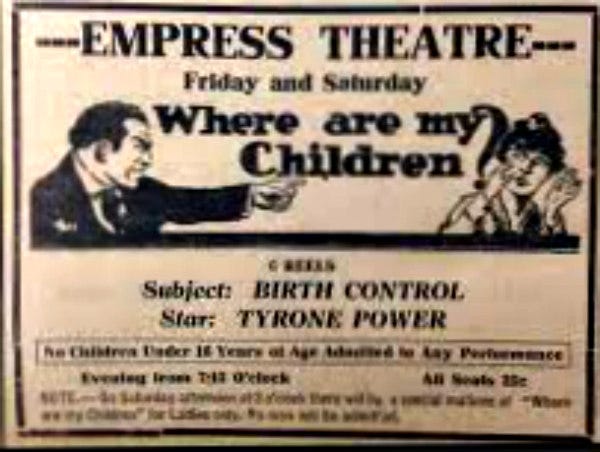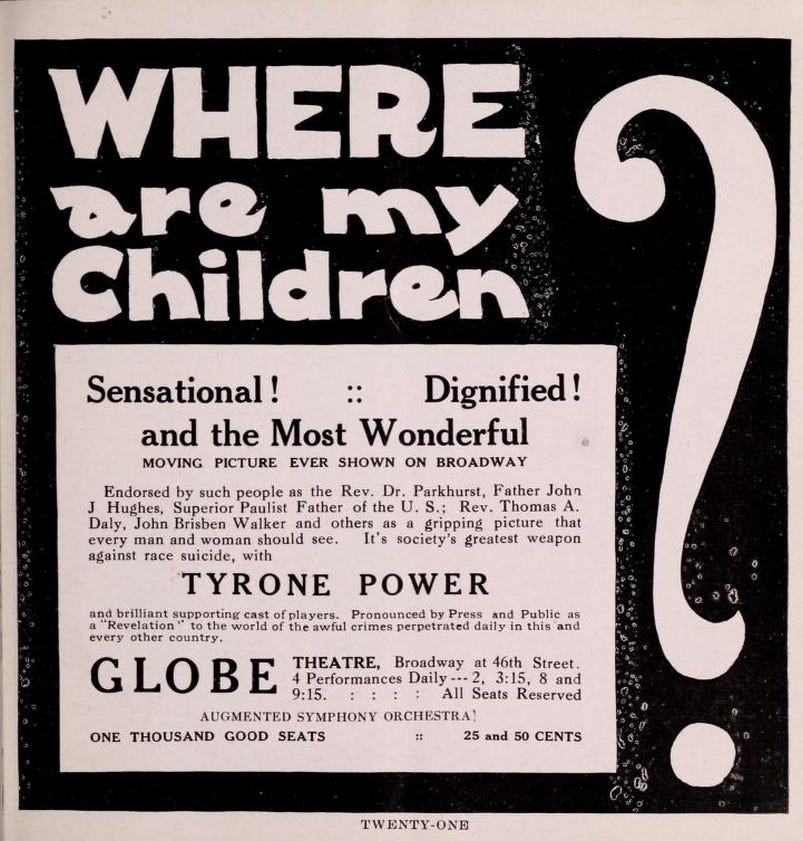Written, directed and produced by Lois Weber (with husband Phillips Smalley, based on a story by Lucy Payton), Where Are My Children is a 1916 film tackling birth control, abortion and rape.
Yep, you read that right.
The opening title card reads:
The question of birth control is now being generally discussed. All intelligent people know that birth control is a subject of serious public interest. Newspapers, magazines and books have treated different phases of this question. Can a subject thus dealt with on the printed page be denied careful dramatization on the motion picture screen? The Universal Film Mfg. Company believes not. I wouldn't say the film is pro-choice exactly - certainly not by 21st century standards - but it's far from pro-forced birth either. It is complex, troubling — and absolutely fascinating.
Very briefly, the plot concerns a lawyer who advocates for women living in poverty to have access to birth control. He later prosecutes a doctor for a botched abortion that kills a young woman, and in revenge, the doctor shows the lawyer his appointment book — which features the lawyer’s own wife. In the final scene, the lawyer and his wife sit in their parlour in lonely old age while the souls of the babies they never had (one of whom is played by then-toddler fifties’ heart-throb Tyrone Power, fact fans!) play around them.
What fascinates me is that a film in 1916 acknowledges the existence of women who don’t want children, just because. There is no question it judges the lawyer’s wife and her friends who prefer to spend their time spoiling their dogs and playing cards rather than popping out babies — there’s one sort of chillingly brilliant moment when one of the society women is in the doctor’s waiting room and she yawns, as though yet another abortion is just so tedious. And it definitely shows the main character’s wife regretting her choice in the end — but, given that we are still debating women’s right to bodily autonomy today, the sheer fact that it presents the decision to remain pregnant or not as hers to make strikes me as surprisingly progressive.
Also, the focus is entirely on women — birth control is presented as a matter of women’s health, women’s well being and women’s lifestyle choices. Regardless of the conservative view it takes on the latter, it depicts abortion as preventing new life from ever having existed, which is refreshing — it’s a low bar! — in the face of today’s “murdered babies” rhetoric. Not to stray too far into non-film politics, but a movie that’s a hundred-and-five years old acknowledges that women are more than “host bodies.”
That said, there is no question that overall, it is far from woke by 21st century standards. There are some very uncomfortable ideas around who “should” have children (i.e. wealthy white women as opposed to poor immigrant women). It’s quite clearly inspired by Margaret Sanger — both her views on birth control and, well, eugenics. (the following year Weber would make another film, The Hand that Rocks the Cradle, which was more explicitly about Sanger’s legal battles). But on the other hand, at no point does it suggest abstinence as a solution to unwanted pregnancy, and when a young girl is raped*, the film is unequivocally on her side. Further, it repeatedly and pointedly presents men in courtrooms making decisions that affect women, while women in parlours quietly pass one another the names of understanding doctors.
* I should note that I’ve read other posts that describe the character as being “seduced” — it may be open to interpretation, but it strikes me that she is clearly taken advantage of.
Where Are My Children was one of Universal’s biggest grossing hits of 1916, and shortly after its release Lois Webber announced that she would now be “producing [movies] independently in my own studio, Lois Weber Productions, for distribution, on their merits.” The venture was backed by Universal’s founder Carl Laemmle, which certainly suggests he was happy with what she was doing!
Where Are My Children’s release wasn’t without controversy; it was banned in Pennsylvania and protested in New York and Ohio. By and large, though, the reception was positive, with many media outlets praising it for proving that serious social issues could be explored by this new art form. It’s a troubling and imperfect film, but I can’t imagine a major Hollywood studio today touching it with a bargepole, and that alone makes it worth a watch.







